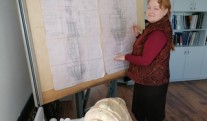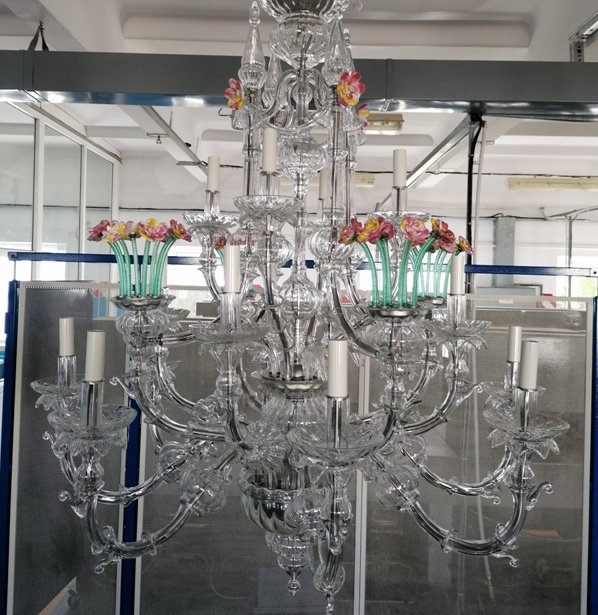Господдержка предприятий-производителей строительных материалов

When two professionals get down to business together, a successful result is guaranteed. This is exactly what the architects of the Grodnograzhdanproekt Institute staked on when they entrusted the reconstruction of lamps for the Old Castle in Grodno to two of our enterprises: Lida's Cascade and Berezovsky's Neman.
But first there was an idea...
I am standing in a spacious room. The rays of the sun penetrate through the huge windows and scatter like a small mosaic over the drawings, sketches, casts, a cup of half-drunk coffee, brushes and pencils... I stand almost motionless, afraid to break the sacramental atmosphere. After all, this is the place where ideas are born. Just think: how many bold projects have been brought to life at this enterprise in 20 years! CJSC "Kaskad" specialists are among the few who manufacture lighting equipment for individual orders. Their unique lamps adorn buildings, historical sites - architectural monuments, leading theaters of Belarus, museums, banks, hotels, sanatoriums... But it all starts here - in the artist's studio. And here, in fact, is the hostess - Alena Tkacheva. She has been working at Cascade for 10 years already: she develops sketches, draws, sculpts, draws, sculpts - in a word, she visualizes ideas. And only when her graphic projects are ready, designers, technologists, chemists, foundry workers and electroplaters start working.
In the hands of Alena - two wooden blanks with embossed stucco. Noticing my interest in these objects, the artist began to arrange them on the table. As it turned out, this is only a part of the details of one "constructor", by assembling which you get something overall, majestic, but still unfinished.
- These are two- and three-meter floor candlesticks with artistic wood carvings that will decorate the Old Castle in Grodno. In the center of the candlestick is a one-meter handmade candle. This is just one of the products of the project we are currently working on, - says Alena, heading towards the drawing board. Attached to the drafting table is graph paper with a sketch of another light fixture.
- And this sconce will be made by the method of artistic casting and a special metal coating, the so-called patination. The main condition is that sconces and other products for the Grodno castle must meet the stylistic features of the late Renaissance. Our task as manufacturers of antiquities is to achieve maximum correspondence to that era.
Why the Renaissance? After all, the Old Castle in Grodno is not called so in vain - it was founded a very long time ago and has survived several eras.
- The old castle in Grodno arose almost simultaneously with the city - in the 11th century. During this time, it has changed many owners. And the castle itself survived in its lifetime and destruction, and restructuring, and restoration - it becomes clear that Alyona owns history as well as a pencil. – Historians have been arguing for a long time about what era the appearance of an architectural pearl should correspond to. And they decided: they would recreate the castle taking into account the architectural approaches adopted in the Renaissance - it was in this era that the castle reached its maximum prosperity. By the way, then the ruler was the King of Poland and the Grand Duke of Lithuania Stefan Batory, who fell in love with the city of Grodno so much that he temporarily moved the capital of the state there.
The king returns to Grodno
Recall that last year a long-awaited event took place in the cultural sphere of our region - the Old Castle in Grodno opened its doors to visitors. However, you can only walk through some of its halls. The fact is that the restoration of the royal residence of Stefan Batory was decided to be carried out in several stages. The first stage of reconstruction was carried out for four years. Now you can visit the entrance gate tower, a gallery with various rooms, a “kamyanitsa” where the royal household lived, and another tower. All this is done almost from scratch.
The design of the second phase began a year ago. It is planned to open seven halls in total. Some will be devoted to the history of the castle, the emergence of the Grodno principality and the development of the ON. Guests will see items found during archaeological excavations of different years. The halls will tell about the personality of King Stefan Batory. One exposition is dedicated to Grodno in the 16th-17th centuries. Work in the royal chapel and alabaster hall continues.
Chandelier for the alabaster hall of Stefan Batory
“And this is, perhaps, the most complex and most interesting product of the entire project – a ceiling chandelier for the alabaster hall, in which Stefan Batory spent more than one hour of his royal life,” the artist unfolded another sketch in front of me. - We worked closely with the craftsmen of the Neman glass factory to make this “flower beauty”.
I look at the "graph paper" and flap my eyelashes incomprehensibly: to me, a person far from the exact sciences, this drawing says absolutely nothing. Alena caught my bewilderment and winked conspiratorially.
- Let's go! Today you have a unique opportunity to see this creation live. Tomorrow the chandelier will go to Grodno.

Taking a goodbye look at the spacious office (after all, not every factory has such an atmospheric place), I followed my “guide”. We walked along the ornate corridors of the enterprise, until we finally found ourselves in the assembly shop. In the middle of the hall, like an elegant Christmas tree, a three-level glass chandelier shimmered and played with all the colors of the rainbow. A truly flowery beauty - how exactly Alena chose the description! Fantasy immediately took me to the Renaissance. It seemed that by the fireplace Stefan Batory was immersed in thoughts either about the upcoming battle with Ivan the Terrible, or about a successful falconry, who knows.
– Only a Venetian glass chandelier can combine so much brilliance, luxury and grace. It is also called Murano. But we didn’t have to go to Italy for it, - my interlocutor smiles. – All glass elements were made by our Berezovsky colleagues. They are true professionals! But all the primary artistic, engineering and design solutions began within the walls of the Cascade.
BY THE WAY
While I was fascinated admiring this work of art (you can’t call it otherwise!), the artist decided to conduct an educational program for me. She said that the legendary Venetian glass began to be called Murano glass after the authorities of Venice moved their production to the island of Murano. This was necessary for two reasons: to protect the city from fires (glassmaking is associated with fire) and to keep unique technologies secret. By the way, their disclosure was punishable by death. And glassmakers were even forbidden to leave the island. Today, the methods of making Venetian glass are no longer a secret - they are owned by many glassblowers around the world. Masters glassworks "Neman" is no exception.
They work with fire
I had no doubt that the Berezovsky glass factory knew their business. But was it easy to retrain from the production of high-quality products - glasses, glasses, wine glasses, vases - to the production of a Renaissance chandelier? I inquired about this from Sergey Ignatchik, Deputy Chief Engineer for Glass Products.
- Each such order is a kind of challenge. We have already collaborated with Cascade specialists when they made lighting for the Palace of Independence in Minsk, Mir and Nesvizh castles, so we had a positive experience of working together. And desire, of course, too. Our masters always work with a twinkle!
– I read that there are a lot of types of Murano glass. What exactly did you have to deal with?
– For each glass element (and for just two such chandeliers, it took as many as 1300 of them!) Molds made at Cascade were used. We used corrugation technology. Its highlight is that corrugated glass refracts rays in the light and creates a flickering effect.
– And what, in your opinion, turned out to be the most difficult in the process of hard work?
- The hardest part is getting it right. Each glass element must match each other, millimeter by millimeter. With the help of an automated line, it would not be difficult to do this: you set the parameters - and the machine stamps. But art glass lends itself only to human hands. And in this case, you can rely only on the eye of the master and his virtuosity. Our guys have done a filigree job.
Revive the renaissance
In total, about thirty ancient lighting compositions were recreated for the Old Castle in Grodno, as well as a number of other artifacts: silver crucifixes, a folding icon, fireplace utensils and even copper tanks for the royal bath. Sergei Gerasimovich, Deputy Director of CJSC Kaskad, spoke about the difficulties encountered in the implementation of this project.
– In recent years, our company has been actively involved in the reconstruction of ancient lamps for architectural monuments, which are centuries old. The greatest complexity of this architectural and artistic process lies in the fact that art historians sometimes have only incomplete and fragmentary information about the products themselves and the technologies for their manufacture. So our specialists have to carefully study old engravings, paintings, museum exhibits, archival and historical documents related to the construction of palaces and castles in Europe and Russia, get acquainted with the features of ancient technologies of bronze casting and gilding, blacksmithing, glass engraving and chasing metal...
– Sergei Nikolaevich, but in the Renaissance, the castle could not be illuminated with electricity. And your lighting fixtures are plugged in. Is this a compromise between old and new?
- You can say that. For any restorer working with lighting fixtures, there is a dilemma: on the one hand, it is required to recreate the past, sometimes lost, technology for making a lamp as accurately as possible, on the other hand, it is impossible to completely repeat it today,” Sergey Gerasimovich explains. – Even at the initial design stage, our specialists inevitably face a problem: how to introduce electrical wiring into the design of a luminaire corresponding, for example, to the 17th century, so that visual losses for the image of the luminaire are minimal.
While Sergey Nikolayevich was telling me about tolerances and landings, electroplating processes, bluing, patination and other wisdom, I involuntarily got distracted by ephemeral reflections. Dozens of professionals from Lida and Berezovka worked on recreating such unique lighting technology. However, these creators are likely to remain in the shadow of their brilliant creations. I really hope that our readers, visiting the Old Castle in Grodno, will not disregard their work and proudly note: our countrymen did it!
Text: Natalia Volkonovskaya (http://lidanews.by/)